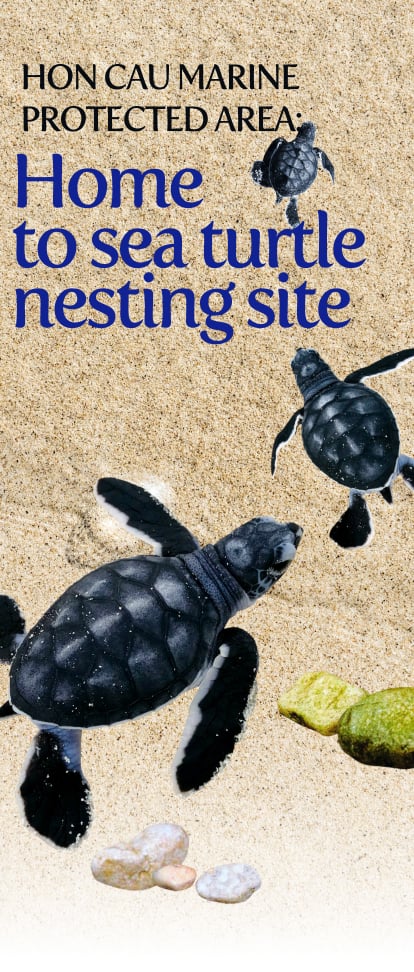
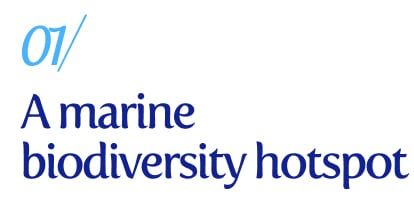
In the last days of March, from Hoang Phuc Pier in Lien Huong Town, Tuy Phong District, Binh Thuan Province, we embarked on a 20-minute boat ride to Hon Cau marine protected area (MPA), approximately 5 nautical miles offshore.
Upon arrival, Hon Cau Island unfolds with its pristine rocky shores resembling naure's masterpieces. During this season, the surrounding seawater is crystal clear, revealing the seabed and coral reefs below.
On the island stands a modestly colored house blending with the sea, home to the four members of the patrol team under the Hon Cau MPA Management Board, who reside day and night to protect and preserve the biodiversity of this marine region.
Hon Cau MPA was established by Decision 2606/QĐ-UBND dated November 15, 2010, by the People's Committee of Binh Thuan Province, covering a total area of 12,500 hectares, including 12,360 hectares of marine area and 140 hectares of island area.
This protected area aims to maintain and protect marine resources, biodiversity, habitats of various species, environmental integrity, promote sustainable economic and ecotourism development, and ensure sustainable management and utilization of marine resources.
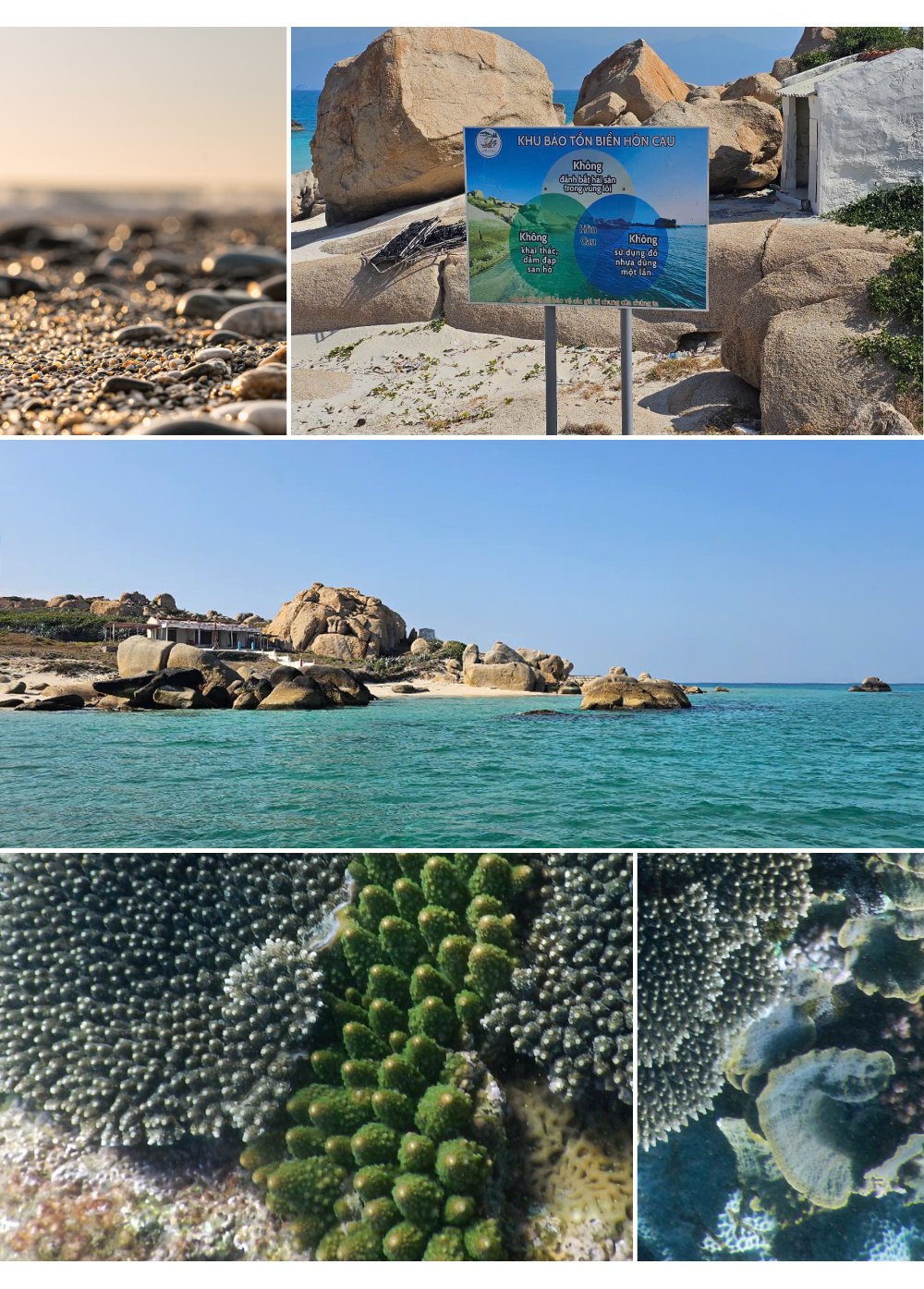
Mr. Nguyen Thanh Phuc, Deputy Director of the Hon Cau MPA Management Board, highlighted that Hon Cau's marine area is highly regarded for its biodiversity, serving as a convergence point for many rare and valuable marine species. The coral reefs here are notably diverse, hosting 282 coral species belonging to 67 genera and 19 families.
Seagrasses and marine algae cover less than 10% of the Hon Cau marine area, predominantly featuring species like Halophila with a total of 163 species, including 44 species of macroalgae. Additionally, there are over 175 species of macrophytes from 3 botanical classes.
The coral reefs teem with a multitude of fish species, totaling around 324 species from 115 genera and 41 families, including butterflyfish, parrotfish, angelfish, surgeonfish, and wrasses. Soft-bodied organisms include 119 species from 71 genera and 42 families, alongside 46 species of crustaceans, including commercially important species like slipper lobsters and red lobsters.
Fish species in the Hon Cau MPA include mullet, anchovy, lizardfish, and barracuda. Importantly, the area is home to endangered and rare species such as sea turtles: green turtle (Chelonia mydas), hawksbill turtle (Eretmochelys imbricata), olive ridley turtle (Lepidochelys olivacea), and the leaherback turtle. Furthermore, Hon Cau Island hosts diverse mollusks, bivalves, and soft-bodied marine organisms.
“With the biodiversity at Hon Cau MPA being a precious resource for scientists and students to study marine ecosystems, thereby contributing to the effective development of conservation strategies,” Mr. Phuc shared.
Hon Cau MPA is home to many rare marine species, including coral, fish, and seabed animals.
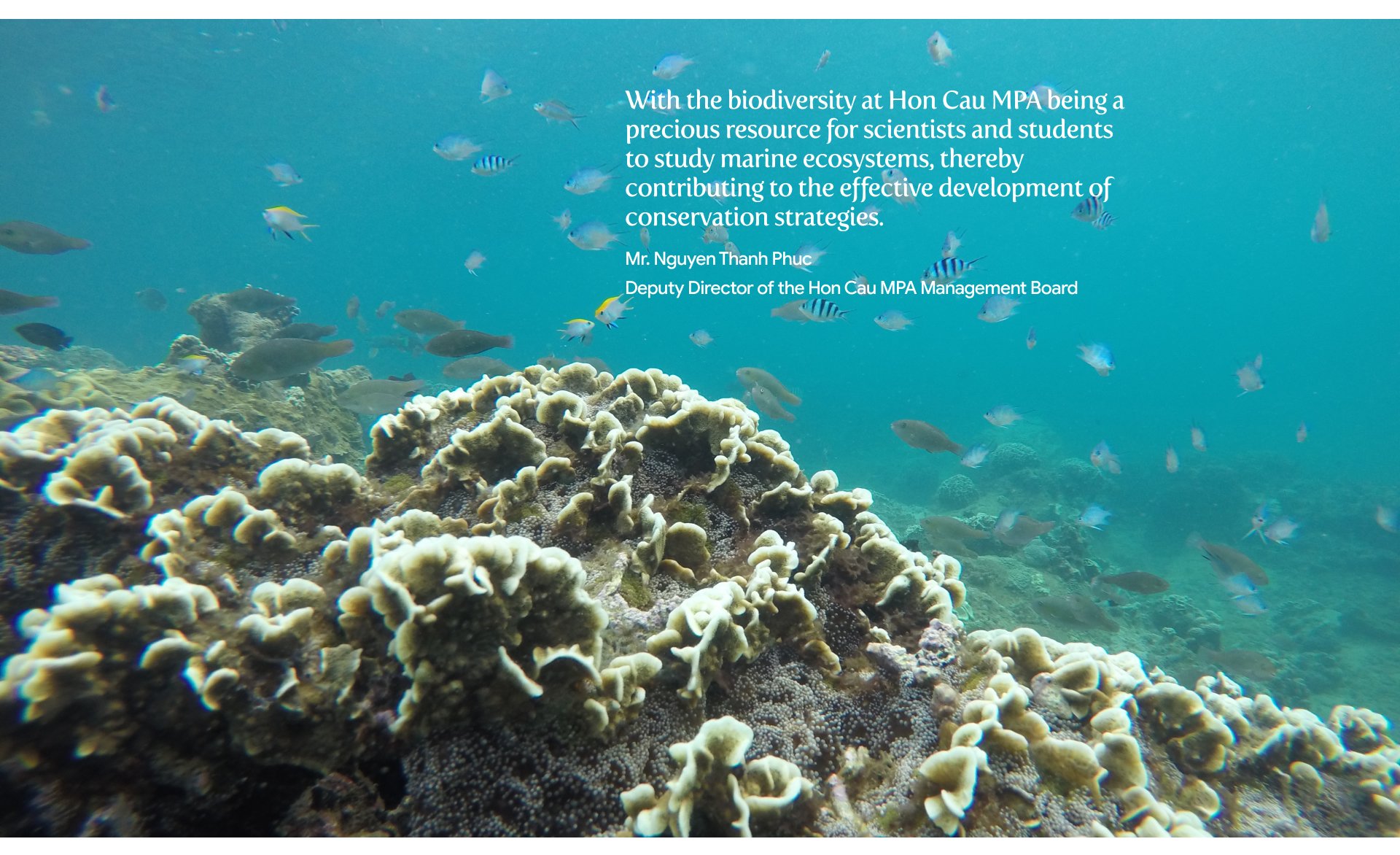


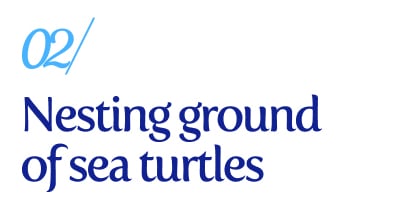
During our tour around Hon Cau Island, Mr. Tran Hoang Phuoc, a member of the Patrol and Monitoring Team (Management Board of Hon Cau MPA), who has been involved with the MPA’s work for 6 years, informed us. Their daily tasks involve patrolling and monitoring around the island to protect functional zones (core and buffer zones) within the conservation area.
In addition, they also protect coral species and assist sea turtles during nesting.
According to Mr. Phuoc, from May to October each year is the sea turtle breeding season. During this time, turtles come ashore on Hon Cau Island to lay eggs. It is when the team takes turns staying up at night to check and monitor the turtles during their breeding season.
"During this season, we all bring blankets and pillows to the rocky shore and wait. If a turtle comes ashore to lay eggs, we know immediately from the sound of her digging. Often, staying up all night waiting for turtles to lay eggs is a normal part of our work," said Mr. Nguyen Sang, head of the Patrol and Monitoring Team, adding that turtles may come ashore to lay eggs at any time, even at 2-3 in the morning. They must wait until the turtles finishing laying eggs before bringing them back to the island's hatchery.
Turtle eggs are placed in nests that mimic natural turtle nests. After burying them, they mark and record the date to monitor the hatching process.
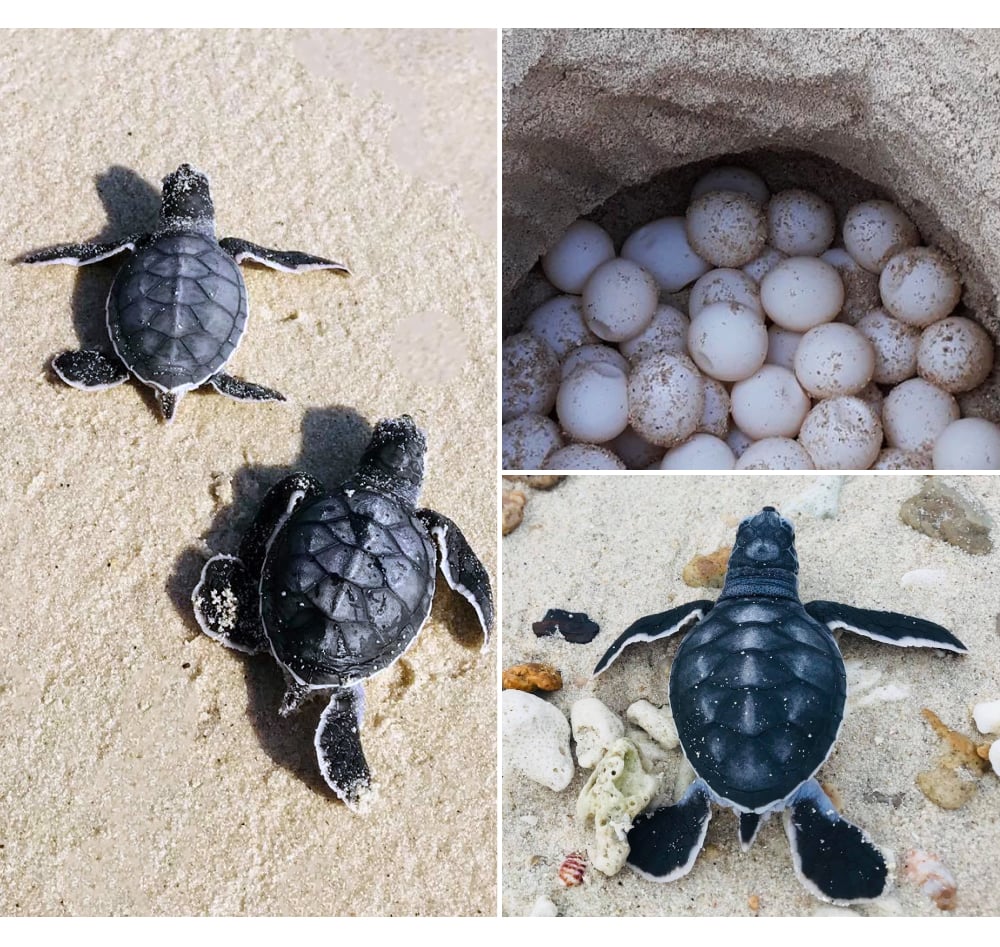
According to Mr. Sang, it takes about 45-60 days (depending on temperature) from the day the eggs are laid until the baby turtles’ hatch. This nesting process signficantly increases the survival rate of turtle eggs and hatchlings, especially in protecting them from potential threats.
Ms. Luu Yen Phi, who has been involved with the Hon Cau MPA since its establishment, shared that the first sea turtle nesting was discovered on Hon Cau Island in July 2013. A green turtle laid 154 eggs on the Tau beach, and after 48 days, 108 baby turtles hatched. The management board then released them back to the sea.
Over the years, the number of sea turtles nesting has gradually increased. In 2017, the management board recorded 15 turtles nesting on Hon Cau, laying 1,389 eggs, which hatched into 1,260 baby turtles. However, since 2022, the number of turtles nesting on Hon Cau has started to decline, with only one green turtle laying eggs and hatching naturally on the island. In 2023, no turtles were recorded nesting on Hon Cau.
However, a positive sign emerged in 2024 when Hon Cau Island recorded six turtle nesting events, with three nests hatching naturally, marking a positive signal for the recovery and strong development of the marine ecosystem there.
When a mother turtle comes ashore to lay eggs, the staff at the Hon Cau MPA will tag it for tracking and relocate the eggs to the hatchery according to proper technical procedures.

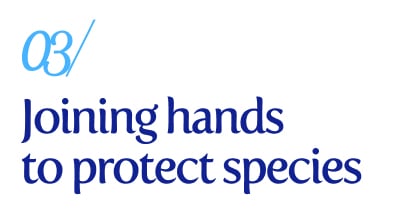
According to Mr. Nguyen Thanh Phuc, Deputy Director of the Hon Cau MPA Management Board, the Hon Cau MPA is one of three marine conservation areas (along with Con Dao National Park and Nui Chua National Park) where turtles come to lay eggs.
Therefore, the protection of sea turtles, one of the species at risk of extinction, is a collective responsibility of all organizations and units working on marine conservation globally. The Hon Cau MPA Management Board also identifies it as one of their key missions.
This is demonstrated by the board's coordination with Tuy Phong District People's Committee, Phuoc The Commune People's Committee, Lien Huong Border Guard Station, Tuy Phong Military Command, international nature conservation organizations (IUCN, UNDP, WAR), local communities, volunteers, and marine conservation collaborators who regularly carry out sea turtle protection efforts.
Each year, the management board creates a detailed plan for protecting sea turtles, assigning and coordinating the staff of the marine conservation area as well as collaborators and volunteers. Additionally, they raise awareness and inform about the penalties for actions such as killing sea turtles for meat, or selling turtle meat and eggs, targeting fishermen and communities within and around the conservation area.
The staff of the Hon Cau MPA is always on standby on the island, organizing patrols and night shifts at turtle nesting areas.

“Before the breeding season, we organize clean-up campaigns at the nesting beaches to ensure the best possible environment for turtle reproduction,” Mr. Phuc shared.
In addition, the management board works with IUCN to run volunteer programs involving doctors, university students, business employees, teachers, architects, journalists, and more to protect sea turtles. All volunteers undergo a training course about sea turtles conducted by IUCN, with each group of volunteers consisting of 8-10 people, who work alongside the staff on Hon Cau Island to carry out tasks like trash collection, awareness campaigns, and patrolling nesting sites.
The conservation team monitors turtle breeding activities in the communes within the marine conservation area, providing information and collaborating with the marine conservation staff to rescue and protect nesting turtles.
Moreover, when sea turtles are reported to be sold at restaurants or kept in captivity, the management staff, along with volunteers and collaborators, encourage the community to voluntarily return the turtles to the wild and sign commitments not to engage in illegal activities. In cases of resistance, the management board will cooperate with authorities (such as the Fisheries Department and the Lien Huong Border Guard) to impose fines in accordance with the law.
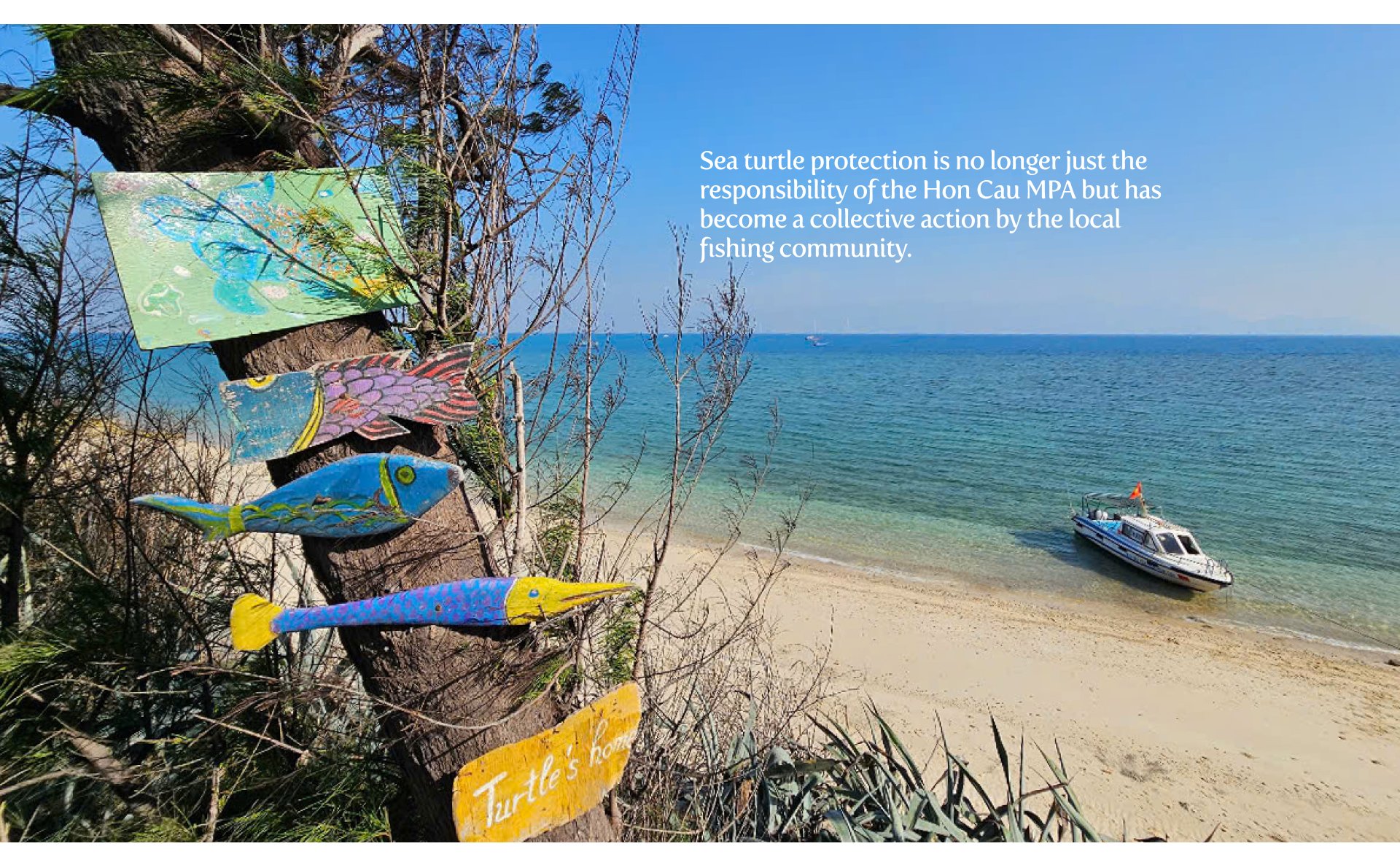
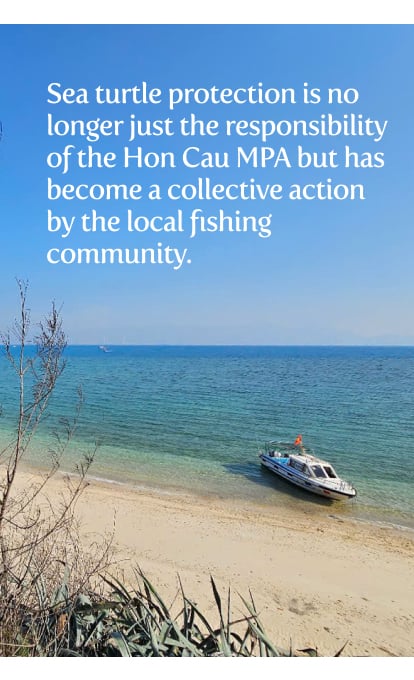
Thanks to these efforts, awareness in the community around the Hon Cau MPA about sea turtle conservation has significantly improved. The sale of turtle meat and eggs has nearly stopped, and local communities now adhere well to regulations protecting sea turtles. Turtles that get entangled in fishing nets are no longer killed but are rescued and released back into the sea.
As a result, the marine conservation work at Hon Cau MPA has been recognized and highly appreciated by the Fisheries Department, local authorities, and international wildlife protection organizations through their support, technical expertise, and financial contributions, as well as the regular exchange of information on turtle protection.
Sea turtle protection is no longer just the responsibility of the Hon Cau MPA but has become a collective action by the local fishing community.

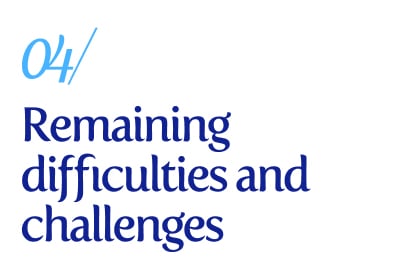
Despite the achievements, marine conservation at Hon Cau Island still faces many difficulties and challenges.
Historically, the waters around Hon Cau Island have always been a traditional fishing ground for local fishermen within and outside the province, so the marine exploitation activities are complex, and boats often anchor in unauthorized locations, creating difficulties for patrols and protection efforts in the conservation area.
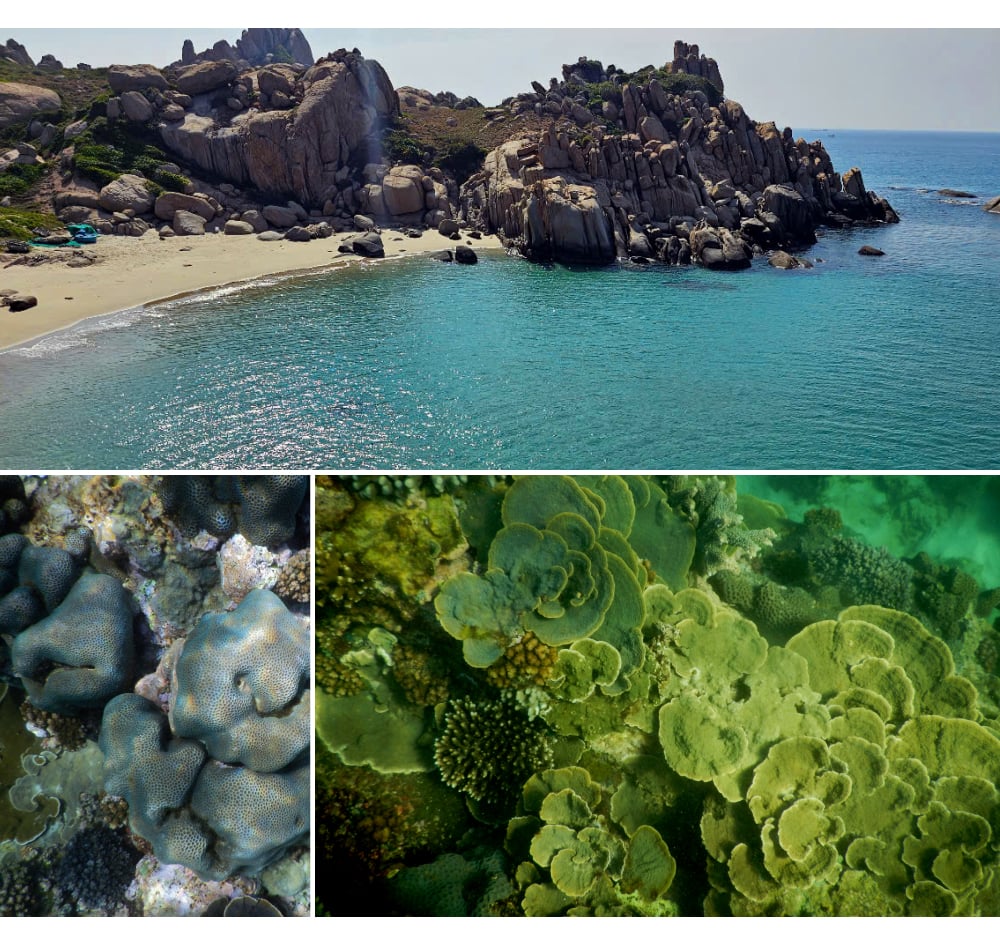
Currently, according to legal regulations, the management board of the marine protected area can only conduct patrols, inspections, and remind violators; it is not permitted to directly handle violations or issue reports for transferring to the relevant authorities for enforcement. Therefore, in the process of protecting functional areas in the protected area from illegal exploitation, the patrol team must collaborate with the competent authorities to handle violations. This coordination can sometimes make management less proactive and less effective.
Additionally, the investment resources for the marine conservation area’s management plan are limited. The operational budget, equipment, and tools for marine conservation work and ecosystem restoration programs have not met the requirements. Support from central authorities for marine conservation activities has not been realized, while finding funding from non-governmental organizations for marine protection remains challenging, with very little support, mostly for awareness campaigns and community activities.
In light of these challenges, the leadership of the Hon Cau MPA Management Board plans to strengthen and improve the management team to meet the tasks assigned. They will also enhance the knowledge and professional capacity of the staff involved in marine conservation, through training, skill development, and learning experiences in marine conservation management.
Furthermore, they aim to raise awareness and responsibilities within the relevant sectors and local governments for better coordination in the management of the conservation area. The management board also plans to intensify the dissemination of legal knowledge, regulations, and guidelines regarding the management of Hon Cau MPA to stakeholders involved in marine conservation, especially fishermen, tourism businesses, tourists, and the local community living around the area, to raise awareness of the importance and benefits of participating in marine conservation efforts.
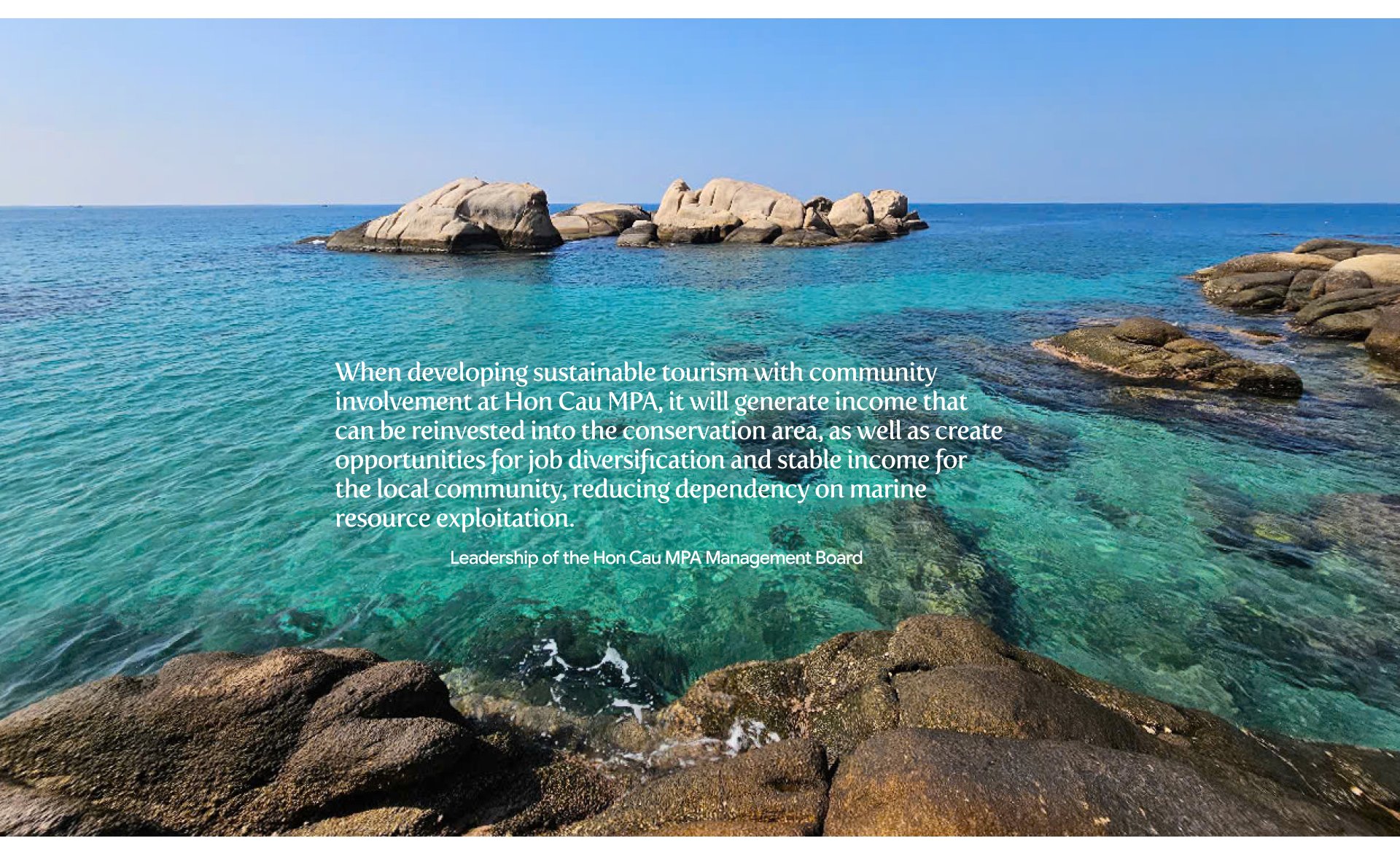
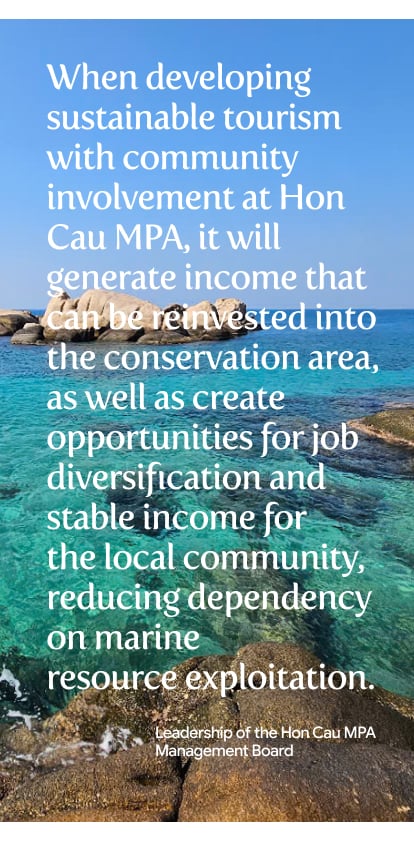
The management board will promote marine conservation education in local schools, organizing discussions and awareness activities about marine biodiversity and environmental protection at schools in Tuy Phong district to improve the awareness of students.
In particular, timely coordination with forces such as Border Patrol, the Fisheries Department, and local governments will be necessary to carry out patrols and controls at the marine conservation area to detect, prevent, and strictly address violations.
In the long term, the management board will implement a plan for sustainable eco-tourism development with the participation of the local community under the supervision and management of the Hon Cau MPA and relevant authorities. This includes setting criteria and directions for developing sustainable tourism that does not place pressure on the protected area.
"When developing sustainable tourism with community involvement at Hon Cau MPA, it will generate income that can be reinvested into the conservation area, as well as create opportunities for job diversification and stable income for the local community, reducing dependency on marine resource exploitation," stated the leadership of the Hon Cau MPA Management Board.



